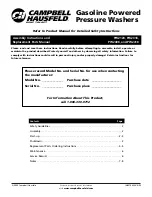
3
Introduction to Parts
1. PRESSURE DIAL GAUGE
The pressure dial gauge registers pressure in both pounds (outer scale) and metric measure (inner scale). The
pointer moves around the dial indicating the pressure within the unit. Before each canning season, check the
pressure dial gauge for accuracy.
2. PRESSURE REGULATOR
The pressure regulator is a solid one-piece unit. Accurate pressure readings are registered on the pressure
dial gauge and can be controlled and maintained by adjusting heat settings.
3. VENT PIPE
The pressure regulator fits over the vent pipe and allows excess pressure to be released.
4. AUTOMATIC AIR VENT
The automatic air vent, located in the center of the Canner cover, does the following: (1) Automatically
vents or exhausts air from the Canner; (2) Automatically releases excess steam in case the vent pipe becomes
clogged and pressure cannot release normally: (3) Acts as an anti-vacuum valve, preventing the loss of juices
from food after pressure is completely reduced; (4) Acts as a visual indication of pressure in the canner.
5. SEALING RING
The sealing ring fits into the Canner cover and forms a pressure-tight seal between the cover and body dur-
ing canning and cooking.
6. CANNING RACK
The canning rack is placed in the bottom of the Canner to hold jars off the bottom of the unit while canning.
Jars may break during the canning process if places on the bottom of the Canner. The canning rack should
always be used when canning.
Use only genuine Presto
replacement parts with your Presto
pressure canner.
How To Use Your Presto
Pressure Canner
IMPORTANT: Read carefully. Do not attempt to use your Canner before reading these instructions.
Follow these step-by-step instructions for canning. Prepare food according to the directions in specific recipe.
1. The first step in pressure canning is to assemble the canning equipment. Be sure your Canner is thoroughly cleaned and working
properly. Before each canning season, check the pressure dial gauge for accuracy. Also check the sealing ring and automatic air vent.
Replace these parts when they become hard, unusually soft, or deformed. (See “General Maintenance”, page 5.)
2. Check mason jars for nicks, cracks, and sharp edges. Check bands for dents or rust. Use only jars, lids, and bands in perfect condition
so an airtight seal may be obtained.
Wash and rinse jars, lids, and bands. Pour hot water into jars and set aside until needed. Follow closure manufacturer’s directions for
bands and lids.
3. For recipe information, see your booklet titled “
Recipes and Helpful Hints for Presto
Pressure Canners
”. Select fresh, firm food.
Sort food according to size. Clean food thoroughly. Prepare according to recipe. Fill hot mason jars promptly with food and liquid
to the recommended level. Allow ½-inch head space for fruits. All vegetables, meat, poultry, and seafood require 1-inch head space
due to expansion during processing. Work out air bubbles with a clean spatula. Wipe sealing edge clean with a damp cloth.
Adjust lids and bands according to closure manufacturer’s directions.
4. Place Canner on a level burner. Use on a tilted burner may interfere with the operation of the pressure regulator. Place three quarts of
boiling water, canning rack, and jars in room temperature Canner. Pouring water into a dry, overheated Canner may crack the metal.
To prevent water stains in Canner or on jars, add 2 tablespoons white vinegar to water in Canner. Place jars on canning rack. Always
use canning rack. Jars may break if set directly on bottom of Canner.
5. Look through the vent pipe to be certain it is open before placing cover on Canner. To clean the vent pipe, draw a pipe cleaner or
small brush through the opening.
DO NOT OPERATE UNTIL YOU
HAVE READ INSTRUCTIONS
psi
kg/cm2
.5
1
1.5
10
15
20
5
0
CA
UT
IO
N
























